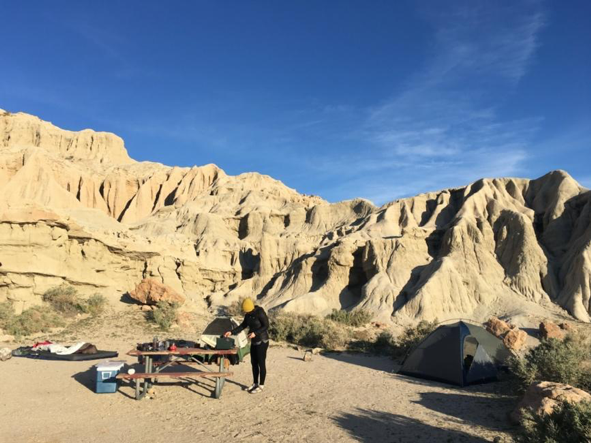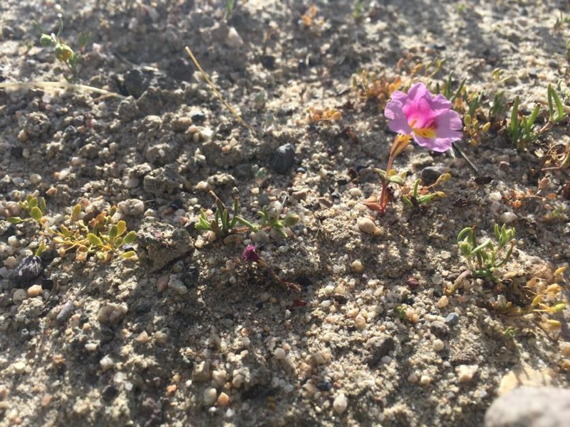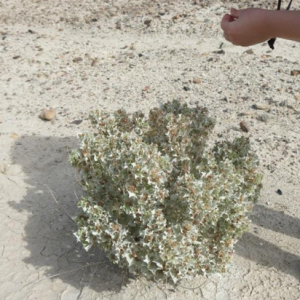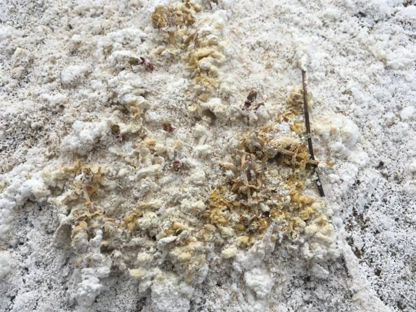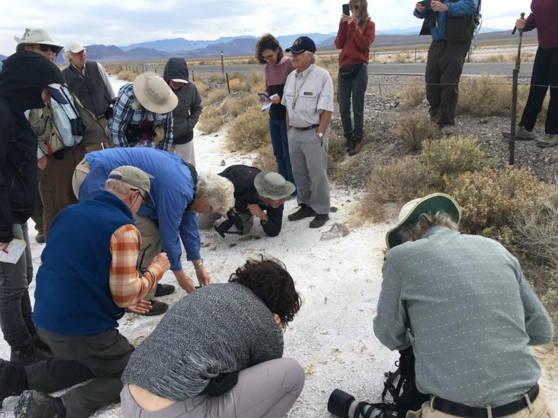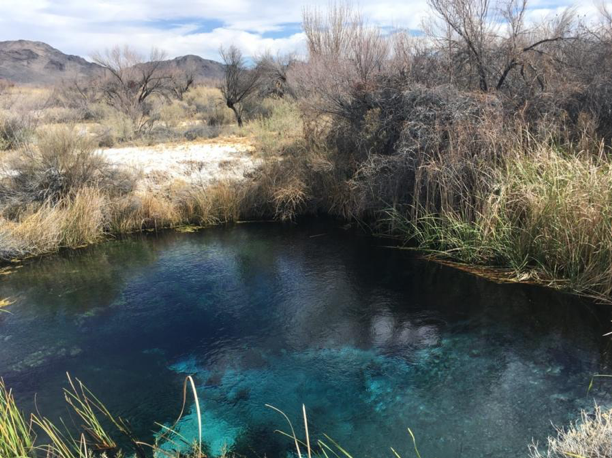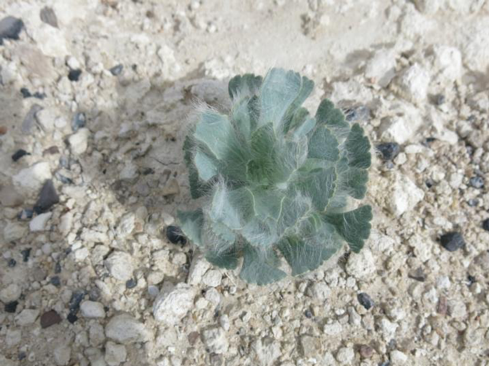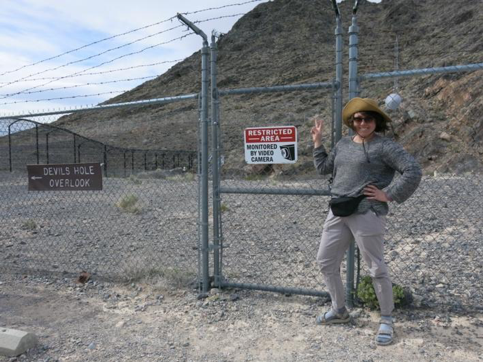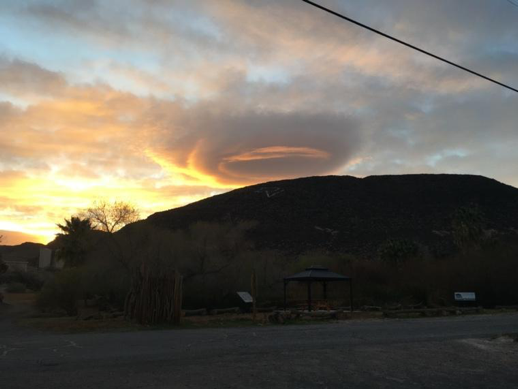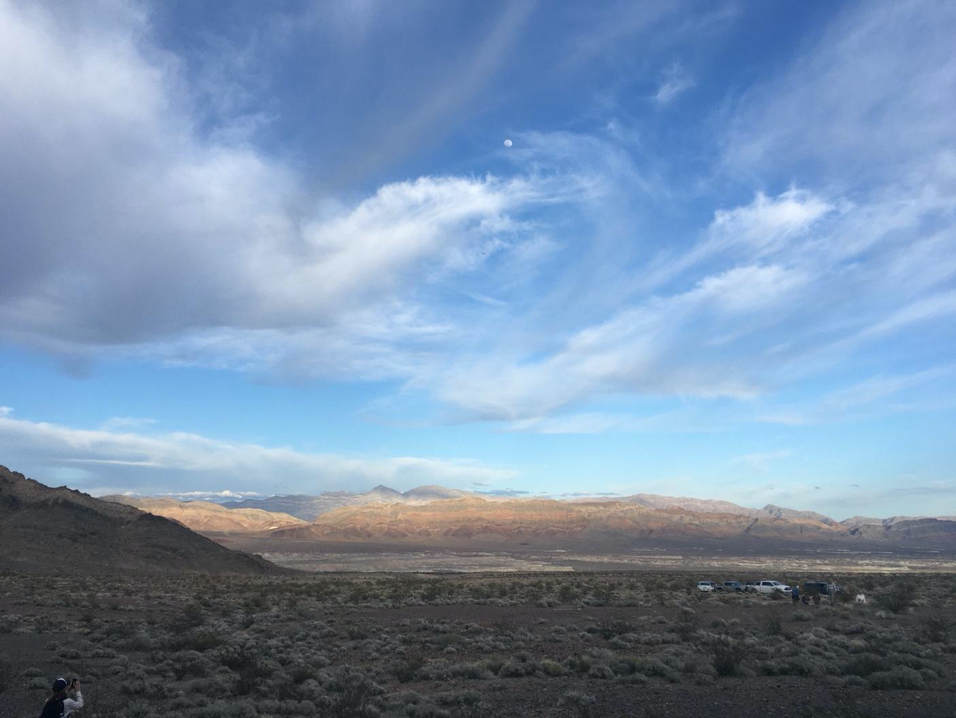
Sophia Warsh, Horticulturist
In early March, before the coronavirus pandemic upended our lives, Assistant Curator Clare Loughran and I headed to Shoshone, California, for a Jepson Herbarium workshop called: Botanical Islands in the Northern Mojave Desert: Exploring the Flora of the Amargosa River Basin. We were lucky to travel with expert botanist Sophie Winitsky, who was coordinating the workshop. Sophie is familiar with the deserts of California and knew a place where we could spend the night on our way to Shoshone. We camped that night at Red Rock Canyon State Park, nestled in a series of ethereal sandstone cliffs. Clare cooked us chili dogs under the stars and we all went to bed excited to be in the desert after our long drive.
In the morning we took a short hike on the Hagen County Nature Trail where we stumbled upon the Red Rock Canyon monkey flower (Erythranthe rhodoptera), which is endemic to Red Rock Canyon State Park! As we prepared to drive off for the last leg of our trip we realized that our morning of botanizing had made us very hungry. Sophie drove us to the town of Mojave, where we had a great breakfast (nopales with scrambled eggs) at the Voyager restaurant in the Mojave Air and Space Port. As we continued on, Sophie pulled over several times to show us all the tiny wildflowers that were scattered in understory of the creosote bush (Larrea tridentata), burro weed (Ambrosia dumosa) and desert trumpet (Eriogonum inflatum).
We arrived in Shoshone that afternoon and we set up our campsite before joining the group for a Mexican potluck at the bunkhouse. That night the group convened at the Flower House (everything in this town has a cute name) for a talk by our workshop leader Naomi Fraga, the head of Conservation at California Botanic Garden (formerly Rancho Santa Ana Botanic Garden). She gave us an exciting slideshow that highlighted the high rates of species discovery that still exist in the California deserts. We were also welcomed by Susan Sorrells, who owns the entire town of Shoshone. As part of her management of the town she is also developing conservation initiatives with Naomi, The Nature Conservancy, and other groups to preserve rare species in the Amargosa River basin.
The next morning, we headed into the Amargosa River Canyon at China Ranch, where Naomi explained the origins of these alkaline wetlands. They are composed of ancient water, remnants of a network of connected lakes from the Pleistocene. We hiked past thickets of mesquite (Prosopis glandulosa var. torreyana) tangled with mistletoe (Phoradendron californica) and discussed the four species of saltbush (Atriplex spp.) we encountered along the way. The desert holly (Atriplex hymenelytra) is a favorite of the group. We spotted desert gold (Gerraea canescens), a common denizen of the valley floor. Everyone crowds around the tiny flowers, including the aptly named small desert star (Monoptilon bellidiforme). We finally made it to the waterfall. Everyone stared at the waterfall in awe while eating snacks. We spotted the rare Cooper’s rush (Juncus cooperi) along the perennial flow below the stands of giant reed (Phragmites australis), some of which might be the native strain. We hiked back to the parking area and everyone got date milkshakes from the farm shop.
We headed to our next destination – the Nopah Range, canyons composed of craggy limestone that Naomi called “tear pants” limestone. While focused on keeping our pants in one piece we scrambled past ephedra (Ephedra spp.)and buckwheat (Eriogonum spp.), pausing for a patch of Parry’s lip fern (Myriopteris parryi) tucked beneath an outcropping, oohing and ahing over a showy Gilia (Gilia cana ssp. speciosa). We kept climbing higher and deeper into the canyon – luckily Clare had introduced me to the wonders of cucumber lime gatorade (limon pepino), so I was able make it through, phew! Then we got to my favorite plant of the day – the desert rue (Thamnosma montana), a blue-black flowered shrub in the citrus family (Rutaceae) that had an unbelievably sweet scent. A seed collection was made of this plant for the garden, and will be added to the Desert Bed in the California Area.
The next day we headed to Lower Carson Slough, an extensive alkaline wetland, where it is always windy. We were there to see the Amargosa niterwort (Nitrophila mojavensis), a member of the Amaranth family, endemic to Nye County, NV and Inyo County, CA. It was just waking up, as Naomi put it, from its sleep in the salty flats surrounded by the skeletons of shortstalk stinkweed (Cleomella brevipes) and salt grass (Distichlis spicata).
Our next stop was the Ash Meadows Wildlife Refuge, the largest remaining oasis in the Mojave Desert with the highest concentration of endemic species in the United States. We immediately saw an endemic species – Ash meadows blazing star (Mentzelia leucophylla). We walked along boardwalks and saw numerous species poking out of the alkali sacaton (Sporobolus airoides) grasslands. We gazed at the blue springs. Some brazen participants dunked their late model iPhones into ponds to try to capture images of the pupfish.
Then we went to the big oasis, for lunch of course. After eating we were able to inspect some screwbean mesquite pods (Prosopis pubescens). It seemed like we had already seen a ton of plants, but we had at least five more places to go that day! We hopped back into our caravan of four-wheel drive vehicles and headed down the road. Suddenly we stopped. It was the moment we had been waiting for – our chance to see the elusive bear poppy (Arctomecon merriamii). New occurrences of this rare plant have recently been discovered as part of the ongoing research in these areas. Everyone crowded around the beautiful basal rosettes. The common name bear poppy refers to the bear paw shape of the leaves.
Arctomecon merriamii
Our next stop was the site of the Devil’s Hole Pupfish – a critically endangered fish, whose entire population lives in Devil’s Hole, a 430 foot deep hole filled with water that is 91°F. The site has been vandalized in recent years, so it now resembles a gated community. Earthquakes from the other side of the world have been known to cause a slosh in Devil’s hole.
Clare at Devil’s Hole
The next morning we met for the finale in 12 Mile Spring in the Chicago Valley. We spent some time pondering how this valley of limestone strata, which was slated to become a marijuana farm before The Nature Conservancy purchased it, was once upon a time an ocean. We poked at some Parry’s wild buckwheat (Eriogonum brachypodum) and spied a blooming desert paintbrush (Castilleja chromosa) hiding behind some plants before returning to our trucks. It’s amazing that there are still new species being found right in our own state, and it was great to get to spend time with people who are finding them!
Our last night in town

